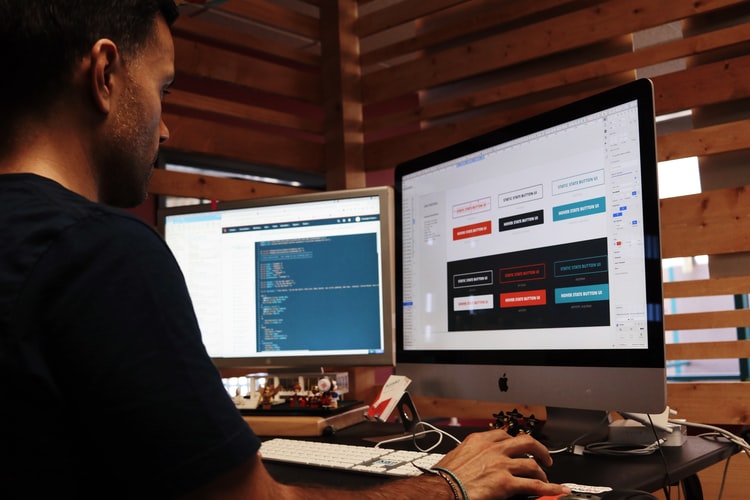6 interesting facts about how web designers are using AI
How has AI changed web design and development?

How has AI changed the web design landscape in 2024?
The best AI website builders, image generators, and content creation tools have made designing and developing feature-complete websites more efficient and accessible than ever before. But how has this affected professionals working in the space? Here are 5 interesting facts about AI in web design, from zero-click search to augmented reality.
#1 Big tech embraces AI in web design
Major tech companies are investing heavily in AI to revolutionize web design. IBM's Watson, Google's AlphaFold, and OpenAI's DALL-E are pushing the boundaries of what's possible in creative content generation. These advancements are trickling down to web development.
For example, Netflix uses machine learning to deliver ultra-personalized recommendations, increasing viewer retention by 75%. Airbnb deploys deep learning to automatically tag and categorize 4+ million listing photos, enhancing search relevance. Asos introduced an AI-powered virtual try-on feature, boosting conversions by 30%. Meanwhile, HubSpot's AI chatbots enable 24/7 support, reducing human workloads by 30%.
As tech giants continue to invest in AI, its impact on web design will only grow.
#2 AI tools boost developer productivity
AI is transforming how websites are built and optimized, even for professional developers. Nearly 36% of web designers use AI tools daily, with 32.8% reporting improved productivity and 25.1% getting better efficiency.
AI assists with tasks like generating imagery, creating page designs, experimenting with design elements, identifying improvements, tracking performance, and auditing user experience.
Developer-friendly website builders like Wix AI use machine learning algorithms to generate custom code and designs from user inputs, streamlining the development process. Squarespace's new AI-powered features like automatic image resizing and search optimization save developers time on routine tasks. Webflow's powerful AI-assisted design tools suggest layouts, color schemes, and typography based on best practices. By leveraging AI, professional developers can focus on higher-level tasks and deliver better results faster.
#3 AR and AI transform web design
Augmented Reality (AR) toolkits are increasingly embracing AI technology to enable creators to develop seamless mixed reality experiences. Apple's ARKit allows developers to create AR-enabled websites that blend digital content with the real world. ZapWorks' AI algorithms optimize AR content for different devices and network conditions, ensuring smooth performance.
Sign up to the TechRadar Pro newsletter to get all the top news, opinion, features and guidance your business needs to succeed!
AI also enhances AR experiences by enabling real-time object recognition, tracking, and rendering. For example, IKEA's AR app uses AI to accurately place furniture in users' homes, helping them visualize products before buying. Sephora's Virtual Artist lets users try on makeup using AR and AI-powered facial tracking. As AI and AR technologies advance, web designers will have new tools to create engaging, personalized, and immersive experiences.
#4 Designers are concerned about AI’s impact on jobs
While artificial intelligence brings many benefits to web design, some designers are worried about its potential impact on the job market. When asked to rank their concern about AI displacing web design jobs on a scale from 1 (not concerned) to 5 (very concerned), 38% of designers gave it a 4, showing significant apprehension.
However, rather than replacing designers entirely, AI is more likely to augment their capabilities and change the nature of their work. As Ginni Rometty, former IBM CEO, said, "Some people call this artificial intelligence, but the reality is this technology will enhance us. So instead of artificial intelligence, I think we'll augment our intelligence."
While it may automate certain tasks, AI will also create new opportunities for designers to focus on higher-level strategic and creative work. By embracing AI as a tool rather than a threat, designers can stay relevant and adapt to the changing landscape of web design.
#5 Web developers adapt to AI search
As artificial intelligence becomes more integrated into search engines, web developers are adapting their strategies to optimize for zero-click searches and voice queries.
Already, Google's RankBrain uses machine learning to understand the intent behind searches and deliver more relevant results. This means developers must focus on creating content that directly answers users' questions and provides value upfront.
Structured data markup helps search engines understand page content and display rich snippets in search results, increasing visibility and click-through rates. Developers are also optimizing for voice search by using natural language, long-tail keywords, and conversational content. Amazon's Alexa and Apple's Siri use AI to interpret voice commands and provide accurate responses, so developers must ensure their sites are compatible with these platforms.
#6 AI deepfakes are eroding user trust
AI-powered deepfakes, which use advanced manipulation techniques to create highly realistic but fake images, videos, and audio, can be used to spread misinformation, impersonate individuals, and manipulate users.
A study by cybersecurity company Deeptrace found that the number of deepfake videos online doubled in just six months to 14,678 in 2019. 96% of these deepfakes were pornographic, often featuring female celebrities without their consent. But a growing number are being used for political disinformation, social engineering scams, and financial fraud.
This is sowing distrust in online media. For web designers, this distrust makes it harder to create credible user experiences. Users may be more hesitant to trust website content, interact with virtual agents or chatbots, or believe testimonials and endorsements. That means working harder to prioritize transparency, using trust signals and verification methods to show that web content is authentic.

Ritoban Mukherjee is a tech and innovations journalist from West Bengal, India. These days, most of his work revolves around B2B software, such as AI website builders, VoIP platforms, and CRMs, among other things. He has also been published on Tom's Guide, Creative Bloq, IT Pro, Gizmodo, Quartz, and Mental Floss.
- Owain WilliamsB2B Editor, Website Builders & CRM